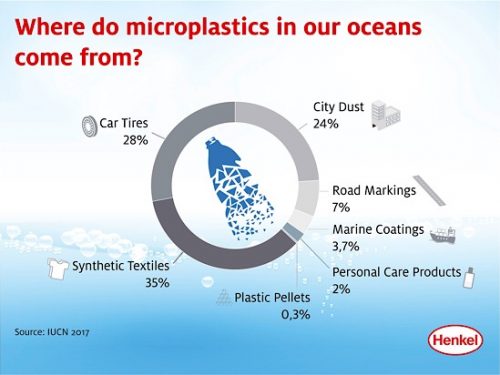 The oceans plastics wastes were byitself a great problem. However, another problem is raising, i.e., microplastics. These tiny particles seems to be another serious environmental discussion. The German chemical company – HENKEL– has recently put it on its spotlight. The following article has been published by Henkel
The oceans plastics wastes were byitself a great problem. However, another problem is raising, i.e., microplastics. These tiny particles seems to be another serious environmental discussion. The German chemical company – HENKEL– has recently put it on its spotlight. The following article has been published by Henkel
Are microplastics a problem – and what’s the solution?
Public awareness of ocean pollution is constantly increasing. But while this improved level of interest can be positive, it can often lead to confusion – especially around specific terminology. The word microplastics is a good example: What exactly are microplastics? Are they the same as plastic?
Microplastics are essentially any type of tiny, solid plastic particle found as litter in oceans and other waterways. It often starts out as larger pieces of plastics that break down into tiny pieces over time (secondary microplastics). These do not dissolve in water, which means that the amount of these materials in our oceans can build up over time.
The public discussion about microplastics often includes microbeads – solid plastic particles five millimeters in size or smaller that are used in some rinse-off peeling and skin exfoliation products. However, the cosmetics industry is estimated to be responsible for just 2 percent of such microplastic pollution (from primary microplastics) and this figure is decreasing.
Microplastics in oceans
The infographic shows the sources of primary microplastics and is based on a study by the International Union for Conservation of Nature (IUCN). Secondary microplastics from plastic waste in oceans that breaks down into tiny pieces over time is not included.
While cosmetic products are only a minor contributor to potential environmental pollution, all cosmetic products launched by Henkel worldwide are made without solid plastic exfoliating particles. We brought together experts from across our business very early on to discuss this topic, speak about alternatives and phase out cosmetic products that still contained microbeads. One of these experts is Andrea Sättler, who leads a product development team within Henkel’s Beauty Care business unit. In an interview, she shares her insights and experience from Henkel’s approach to this topic.

Image: Dr. Andrea Sättler
When did Henkel identify microbeads as a potential problem?
We became aware of this topic back in 2012. At that time, the issue wasn’t really present in the media and only a handful of NGOs were beginning to draw more attention to it. We very quickly recognized that we needed to find a solution, because we were using microbeads in a few of our rinse-off facial and body care products back then. Sustainability has always been one of our strongest values at Henkel – so we couldn’t afford to waste any time before finding a solution.
How did Henkel react?
We brought together colleagues from across departments to identify how this challenge affected our product range and make sure we were a frontrunner in responding to it. Together, we jumped straight into the work and decided early on to use alternative abrasive materials like quartz sand whenever possible. We also stopped using microbeads in our cosmetic formulations. It was a really dynamic process, and everybody involved made an active contribution.
What have you achieved?
Our efforts have already achieved a lot. Since 2014, there have been no microbeads in our new cosmetic products launched in Europe. And at the beginning of 2016, we stopped using microbeads in any of our new cosmetic products launched anywhere in the world. I think we can be proud of this because our decision came well ahead of the recommendation issued by Cosmetics Europe in October 2015 – where it called for solid plastic exfoliation beads in rinse-off cosmetic products to be completely abolished by 2020. In the meantime, the cosmetics industry in Europe has reduced the amount of microbeads in its products by 97 percent between 2012 and 2017.
************************
Why Should Be “A Paid-Subscriber” and “Advertiser”
Keeping an independent media in countries that impose limitations on self supporting media, will help to support the humankind’s freedom. If you believe it, please act to be a PRO-MEMBER by clicking “HERE“, or:
Please send your PR’s directly to my email address to be published in the world via ” http://pimi.ir ” my address is: aasaatnia@live.com
Please read the whole article at: Why are microplastics a problem – and what’s the solution?













